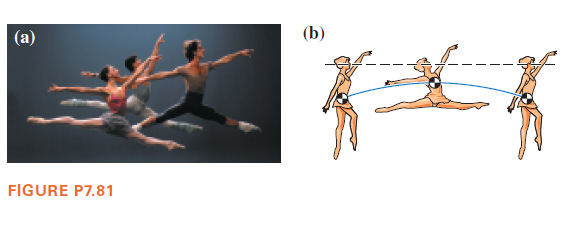(a) (b) FIGURE P7.81
The grand jeté is a classic ballet maneuver in which a dancer executes a horizontal leap while moving her arms and legs up and then down. At the center of the leap, the arms and legs are gracefully extended, as we see in P7.81a. The goal of the leap is to create the illusion of flight. As the dancer moves through the air, he or she is in free fall. But what part of the dancer follows the usual parabolic path? It won’t come as a surprise to learn that it’s the center of gravity. But when you watch a dancer leap through the air, you don’t watch her center of gravity, you watch her head. If the translational motion of her head is horizontal—not parabolic—this creates the illusion that she is flying through the air, held up by unseen forces.
P7.81b illustrates how the dancer creates this illusion. While in the air, she changes the position of her center of gravity relative to her body by moving her arms and legs up, then down. Her center of gravity moves in a parabolic path, but her head moves in a straight line. It’s not flight, but it will appear that way, at least for a moment.
To perform this maneuver, the dancer relies on the fact that the position of her center of gravity
A. Is near the center of the torso.
B. Is determined by the positions of her arms and legs.
C. Moves in a horizontal path.
D. Is outside of her body.

Trending now
This is a popular solution!
Step by step
Solved in 2 steps with 2 images
